Abstract
An outbreak of bacteremia and meningitis in a neonatal intensive care unit is described. Seven cases occurred in premature infants with severe underlying diseases. An epidemiological investigation failed to document the reservoir of the epidemic strain but suggested that its transmission among the infants was via the hands of hospital personnel. All patients had nasogastric tubes and multiple intravascular devices, and the portal of entry may have been either the gastrointestinal tract or the sites of the intravascular devices. Conventional biotyping of isolates failed to differentiate between isolates from infected patients and isolates recovered from prevalence surveys and from the environment. However, rapid identification systems (API-20S [Analytab Products, Plainview, N.Y.] and the AutoMicrobic system [Vitek Systems, Inc., Hazelwood, Mo.]) were able to distinguish isolates recovered from infected patients and hands of hospital personnel from isolates recovered during prevalence and environmental surveys and 29 isolates from widespread geographical areas. This is the first known report of a nosocomial neonatal outbreak of bacteremia and meningitis due to Streptococcus faecium; it underscores the importance of identifying streptococci to species level.
Full text
PDF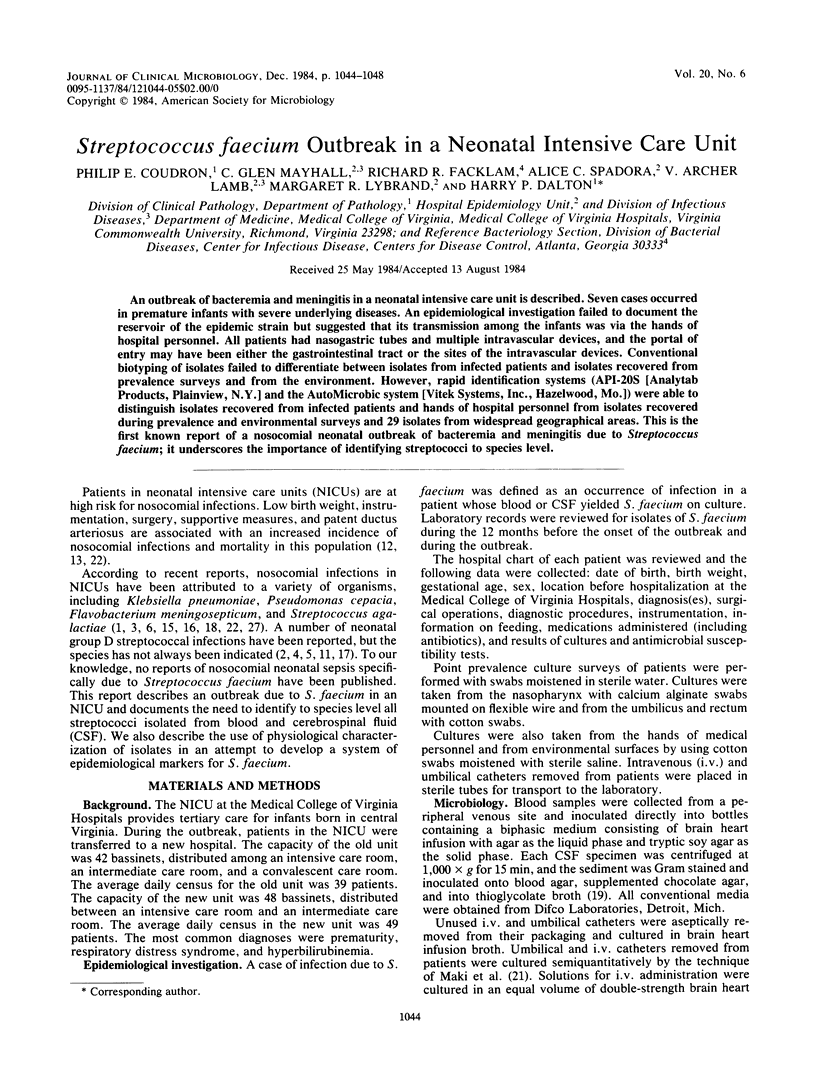
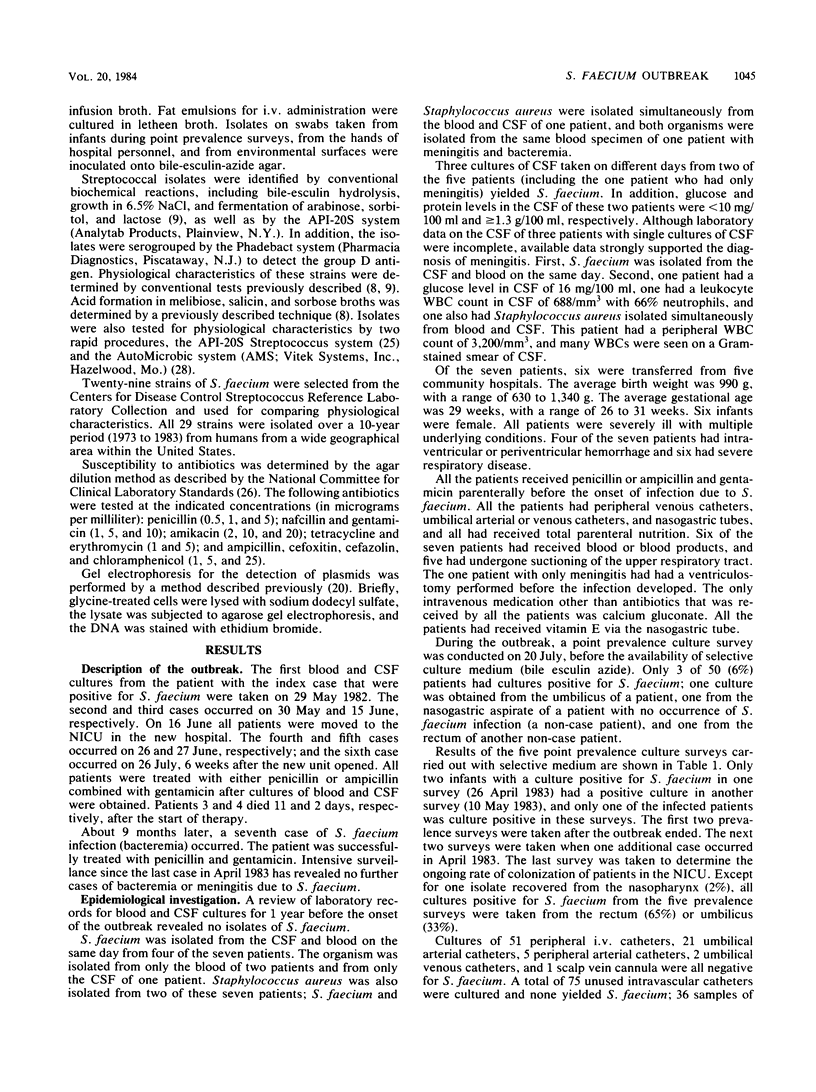
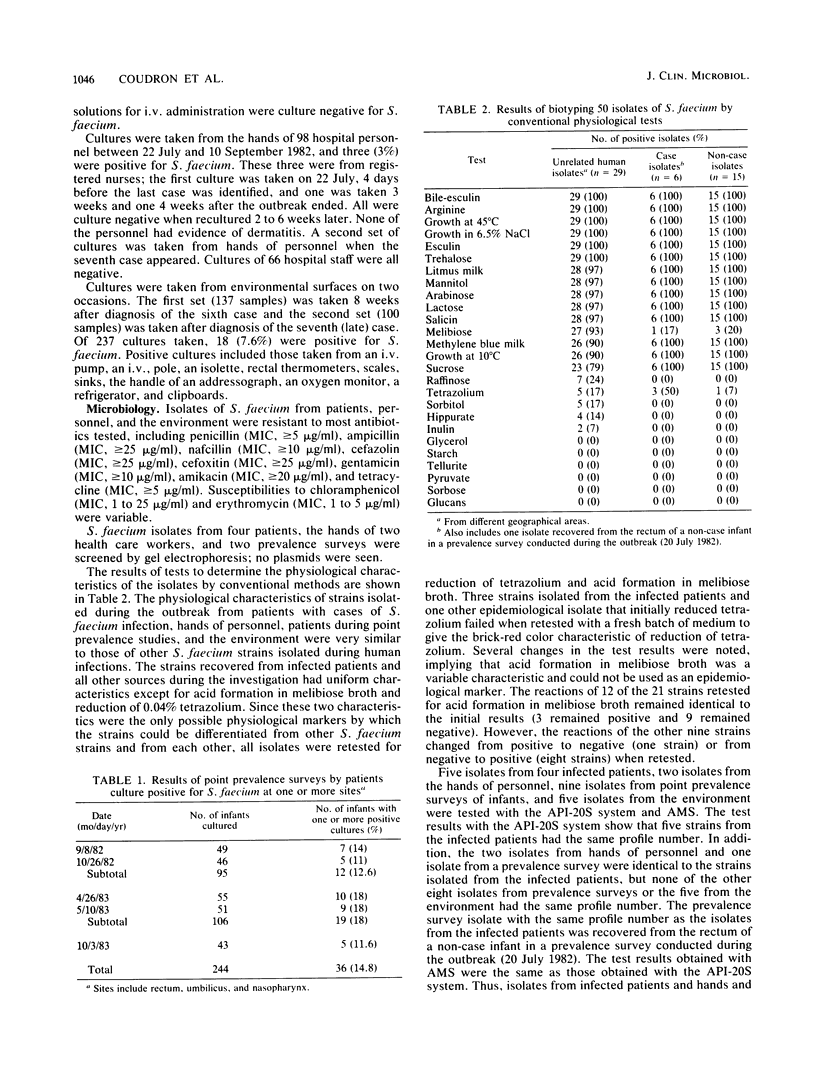
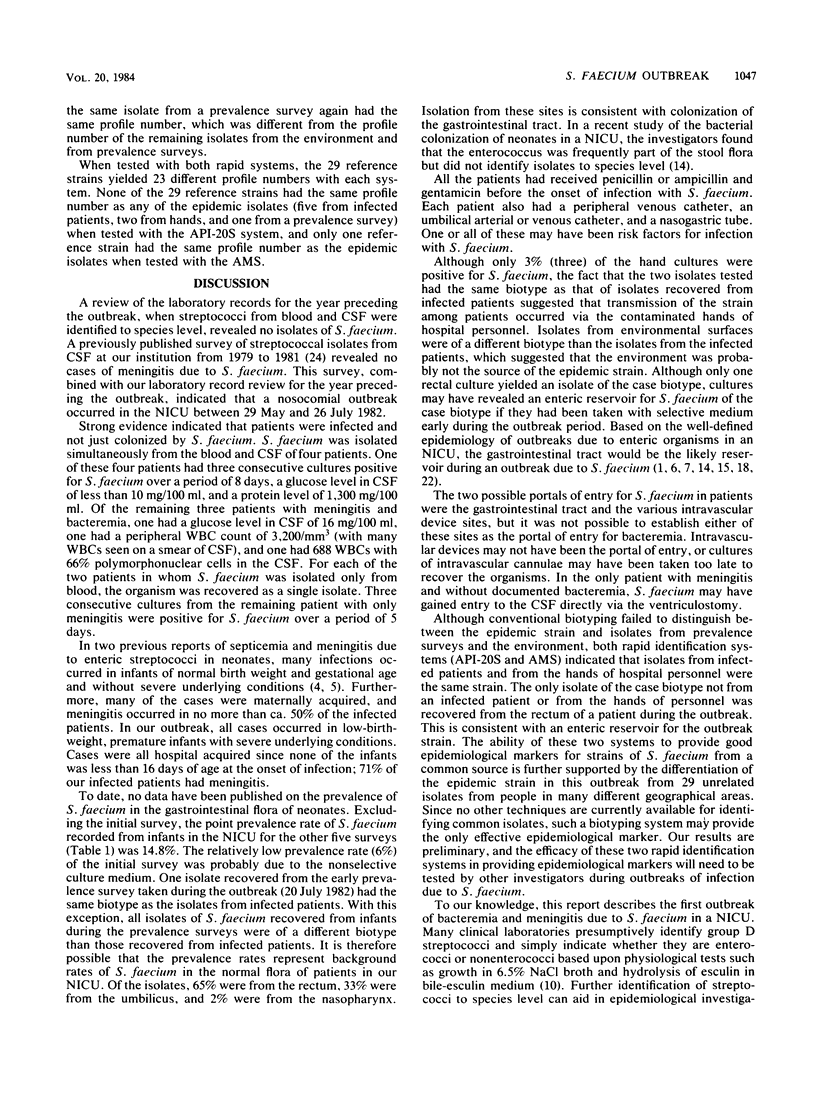
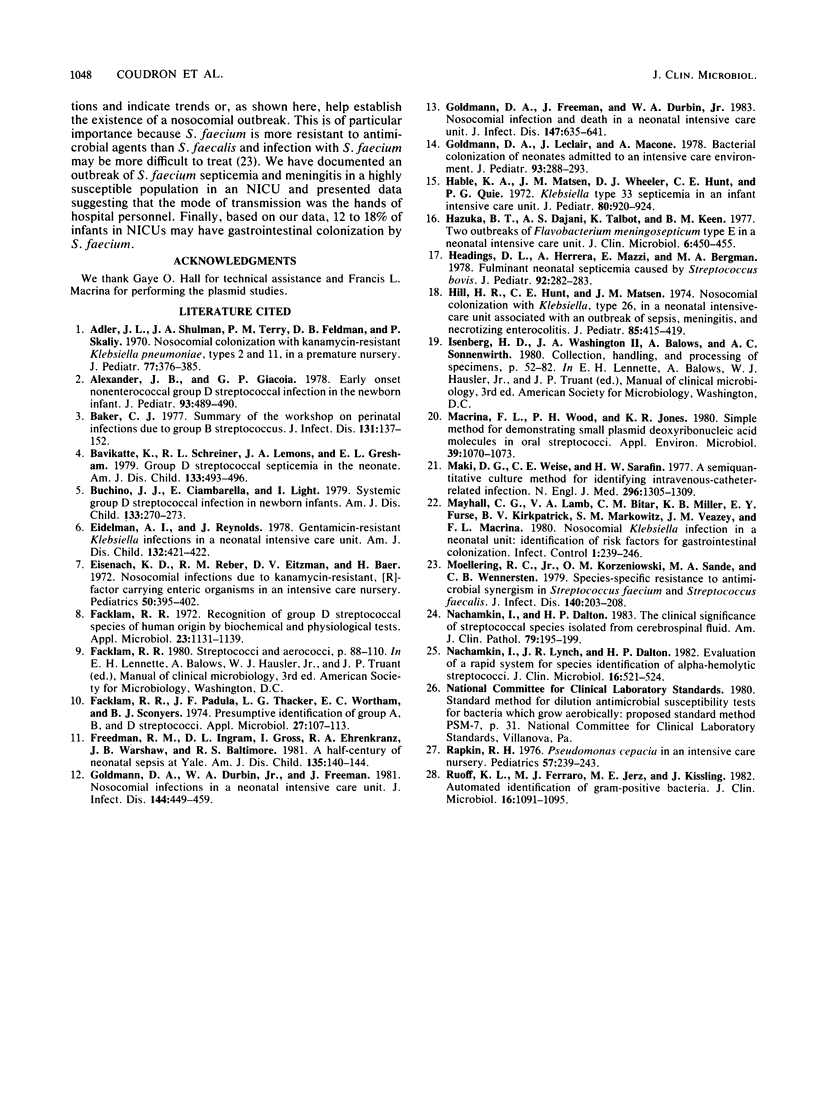
Selected References
These references are in PubMed. This may not be the complete list of references from this article.
- Adler J. L., Shulman J. A., Terry P. M., Feldman D. B., Skaliy P. Nosocomial colonization with kanamycin-resistant Klebsiella pneumoniae, types 2 and 11, in a premature nursery. J Pediatr. 1970 Sep;77(3):376–385. doi: 10.1016/s0022-3476(70)80004-x. [DOI] [PubMed] [Google Scholar]
- Alexander J. B., Giacoia G. P. Early onset nonenterococcal group D streptococcal infection in the newborn infant. J Pediatr. 1978 Sep;93(3):489–490. doi: 10.1016/s0022-3476(78)81173-1. [DOI] [PubMed] [Google Scholar]
- Bavikatte K., Schreiner R. L., Lemons J. A., Gresham E. L. Group D streptococcal septicemia in the neonate. Am J Dis Child. 1979 May;133(5):493–496. doi: 10.1001/archpedi.1979.02130050037008. [DOI] [PubMed] [Google Scholar]
- Buchino J. J., Ciambarella E., Light I. Systemic group D streptococcal infection in newborn infants. Am J Dis Child. 1979 Mar;133(3):270–273. doi: 10.1001/archpedi.1979.02130030046007. [DOI] [PubMed] [Google Scholar]
- Eidelman A. I., Reynolds J. Gentamicin-resistant Klebsiella infections in a neonatal intensive care unit. Am J Dis Child. 1978 Apr;132(4):421–422. doi: 10.1001/archpedi.1978.02120290093019. [DOI] [PubMed] [Google Scholar]
- Eisenach K. D., Reber R. M., Eitzman D. V., Baer H. Nosocomial infections due to kanamycin-resistant, (R)-factor carrying enteric organisms in an intensive care nursery. Pediatrics. 1972 Sep;50(3):395–402. [PubMed] [Google Scholar]
- Facklam R. R., Padula J. F., Thacker L. G., Wortham E. C., Sconyers B. J. Presumptive identification of group A, B, and D streptococci. Appl Microbiol. 1974 Jan;27(1):107–113. doi: 10.1128/am.27.1.107-113.1974. [DOI] [PMC free article] [PubMed] [Google Scholar]
- Facklam R. R. Recognition of group D streptococcal species of human origin by biochemical and physiological tests. Appl Microbiol. 1972 Jun;23(6):1131–1139. doi: 10.1128/am.23.6.1131-1139.1972. [DOI] [PMC free article] [PubMed] [Google Scholar]
- Freedman R. M., Ingram D. L., Gross I., Ehrenkranz R. A., Warshaw J. B., Baltimore R. S. A half century of neonatal sepsis at Yale: 1928 to 1978. Am J Dis Child. 1981 Feb;135(2):140–144. doi: 10.1001/archpedi.1981.02130260032010. [DOI] [PubMed] [Google Scholar]
- Goldmann D. A., Durbin W. A., Jr, Freeman J. Nosocomial infections in a neonatal intensive care unit. J Infect Dis. 1981 Nov;144(5):449–459. doi: 10.1093/infdis/144.5.449. [DOI] [PubMed] [Google Scholar]
- Goldmann D. A., Freeman J., Durbin W. A., Jr Nosocomial infection and death in a neonatal intensive care unit. J Infect Dis. 1983 Apr;147(4):635–641. doi: 10.1093/infdis/147.4.635. [DOI] [PubMed] [Google Scholar]
- Goldmann D. A., Leclair J., Macone A. Bacterial colonization of neonates admitted to an intensive care environment. J Pediatr. 1978 Aug;93(2):288–293. doi: 10.1016/s0022-3476(78)80523-x. [DOI] [PubMed] [Google Scholar]
- Hable K. A., Matsen J. M., Wheeler D. J., Hunt C. E., Quie P. G. Klebsiella type 33 septicemia in an infant intensive care unit. J Pediatr. 1972 Jun;80(6):920–924. doi: 10.1016/s0022-3476(72)80002-7. [DOI] [PubMed] [Google Scholar]
- Hazuka B. T., Dajani A. S., Talbot K., Keen B. M. Two outbreaks of Flavobacterium meningosepticum type E in a neonatal intensive care unit. J Clin Microbiol. 1977 Nov;6(5):450–455. doi: 10.1128/jcm.6.5.450-455.1977. [DOI] [PMC free article] [PubMed] [Google Scholar]
- Headings D. L., Herrera A., Mazzi E., Bergman M. A. Fulminant neonatal septicemia caused by Streptococcus bovis. J Pediatr. 1978 Feb;92(2):282–283. doi: 10.1016/s0022-3476(78)80026-2. [DOI] [PubMed] [Google Scholar]
- Hill H. R., Hunt C. E., Matsen J. M. Nosocomial colonization with Klebsiella, type 26, in a neonatal intensive-care unit associated with an outbreak of sepsis, meningitis, and necrotizing enterocolitis. J Pediatr. 1974 Sep;85(3):415–419. doi: 10.1016/s0022-3476(74)80133-2. [DOI] [PubMed] [Google Scholar]
- Macrina F. L., Wood P. H., Jones K. R. Simple method for demonstrating small plasmid deoxyribonucleic acid molecules in oral streptococci. Appl Environ Microbiol. 1980 May;39(5):1070–1073. doi: 10.1128/aem.39.5.1070-1073.1980. [DOI] [PMC free article] [PubMed] [Google Scholar]
- Maki D. G., Weise C. E., Sarafin H. W. A semiquantitative culture method for identifying intravenous-catheter-related infection. N Engl J Med. 1977 Jun 9;296(23):1305–1309. doi: 10.1056/NEJM197706092962301. [DOI] [PubMed] [Google Scholar]
- Mayhall C. G., Lamb V. A., Bitar C. M., Miller K. B., Furse E. Y., Kirkpatrick B. V., Markowitz S. M., Veazey J. M., Jr, Macrina F. L. Nosocomial klebsiella infection in a neonatal unit: identification of risk factors for gastrointestinal colonization. Infect Control. 1980 Jul-Aug;1(4):239–246. doi: 10.1017/s019594170005308x. [DOI] [PubMed] [Google Scholar]
- Moellering R. C., Jr, Korzeniowski O. M., Sande M. A., Wennersten C. B. Species-specific resistance to antimocrobial synergism in Streptococcus faecium and Streptococcus faecalis. J Infect Dis. 1979 Aug;140(2):203–208. doi: 10.1093/infdis/140.2.203. [DOI] [PubMed] [Google Scholar]
- Nachamkin I., Dalton H. P. The clinical significance of streptococcal species isolated from cerebrospinal fluid. Am J Clin Pathol. 1983 Feb;79(2):195–199. doi: 10.1093/ajcp/79.2.195. [DOI] [PubMed] [Google Scholar]
- Nachamkin I., Lynch J. R., Dalton H. P. Evaluation of a rapid system for species identification of alpha-hemolytic streptococci. J Clin Microbiol. 1982 Sep;16(3):521–524. doi: 10.1128/jcm.16.3.521-524.1982. [DOI] [PMC free article] [PubMed] [Google Scholar]
- Rapkin R. H. Pseudomonas cepacia in an intensive care nursery. Pediatrics. 1976 Feb;57(2):239–243. [PubMed] [Google Scholar]
- Ruoff K. L., Ferraro M. J., Jerz M. E., Kissling J. Automated identification of gram-positive bacteria. J Clin Microbiol. 1982 Dec;16(6):1091–1095. doi: 10.1128/jcm.16.6.1091-1095.1982. [DOI] [PMC free article] [PubMed] [Google Scholar]


